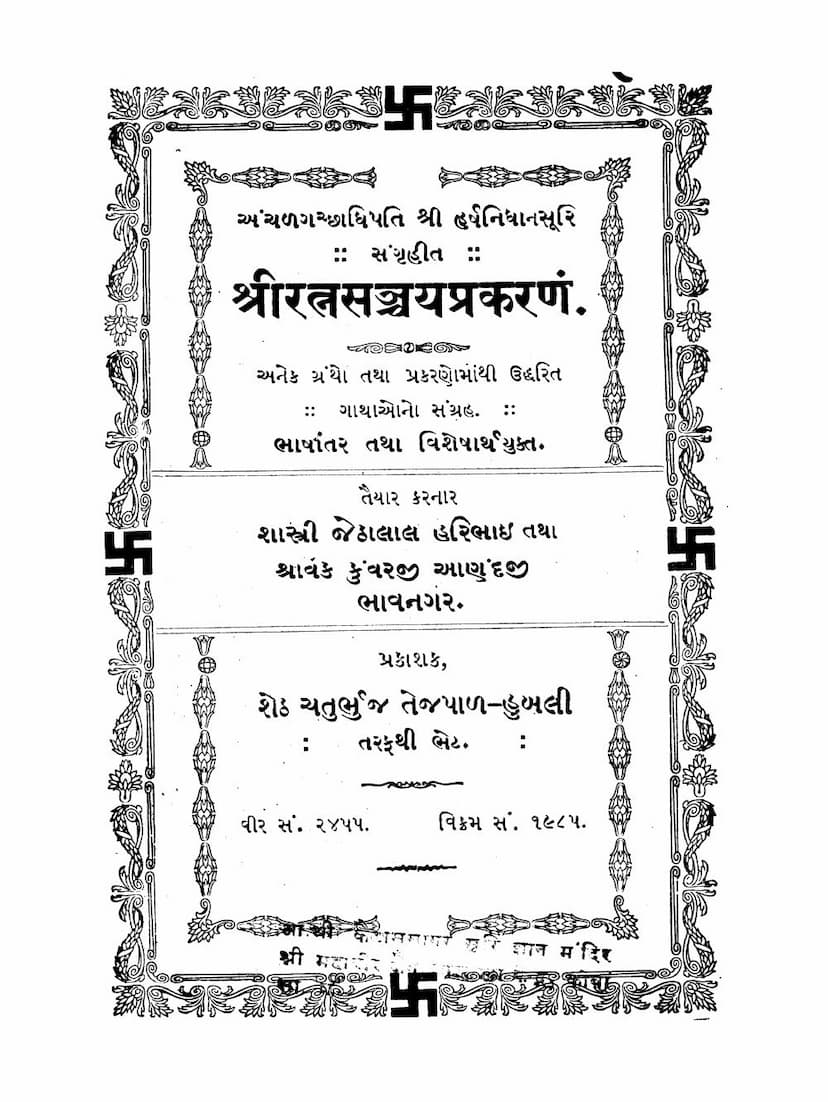Ratnasanchay Prakaranam
Added to library: September 2, 2025

Summary
Here's a comprehensive summary of the Jain text "Ratnasanchay Prakaranam" by Harshnidhansuri, based on the provided pages:
Book Title: Ratnasanchay Prakaranam (Collection of Jewels) Author: Harshnidhansuri Publisher: Sheth Chaturbhuj Tejpal Hubli Compilation: A collection of verses (Gathas) extracted from various scriptures and treatises. Translation and Commentary: Prepared by Shastri Jethalal Haribhai and Shravak Kunvarji Anandji of Bhavnagar. Publication Date: Vikram Samvat 1985 (corresponding to 2455 Jain year).
Core Message and Purpose:
The "Ratnasanchay Prakaranam" is presented as a concise compilation of essential spiritual truths and teachings from the vast ocean of Jain scriptures. Its primary purpose is to provide a distilled essence of Jain philosophy for the benefit of modern humans, who have shorter lifespans and are engaged in worldly activities. The book aims to offer profound spiritual guidance that is accessible and beneficial in contemporary times.
Key Themes and Content:
-
The Goal of Liberation (Mukti): The text emphasizes that the ultimate destination for a soul wandering through the cycle of four births (chatur-gati) is the fifth state, liberation (Mukti), which offers eternal and unending bliss.
-
The Path to Liberation: The main path to achieving this liberation lies in the acquisition of three precious gems: Right Knowledge (Samyak-Darshan), Right Knowledge (Samyak-Gyan), and Right Conduct (Samyak-Charitra).
-
The Fourfold Approach (Chatur-Anuyog): The book draws upon the four main analytical approaches of Jain scripture:
- Dravyanuyog: Deals with the substances or reality.
- Ganitanuyog: Deals with mathematics and cosmological calculations.
- Charanakranuyog: Deals with the rules of conduct and practices.
- Charitanuyog: Deals with the stories and lives of great souls.
-
The "Jewels" of Wisdom: The title "Ratnasanchay" (Collection of Jewels) signifies that the verses compiled within are like precious jewels, each offering valuable spiritual insight. These verses are presented as extracted from the vast "ocean of the Jinagam" (Jain scriptures) by the benevolent Acharya Harshnidhi Suri.
-
Accessibility and Conciseness: The compilation acknowledges the vastness of Jain literature, which can be overwhelming for individuals with limited lifespans. Therefore, it presents an ultra-concise summary of key subjects, making spiritual learning more manageable.
-
Inclusivity of Topics: The book covers a wide spectrum of Jain teachings, as evidenced by the detailed table of contents. These topics range from:
- Cosmology and Geography: Descriptions of Mount Meru, Jambudvipa, different realms of existence, and the structure of the universe.
- Tirthankaras and Spiritual Hierarchy: Details about the Tirthankaras, Chakravartis, Vasudevas, Baladevas, and their lineage, as well as the merits of various spiritual beings.
- Daily Practices and Observances: Discussions on various vows (Vratas), austerities (Tapa), types of equanimity (Samayika), and the proper conduct for monks and laypeople (Shravakas).
- Ethical Principles: Emphasis on non-violence (Ahimsa), forgiveness (Kshama), truthfulness (Satya), and the importance of right conduct.
- The Nature of the Soul and Karma: Insights into the soul's journey, the workings of karma, and the process of spiritual purification.
- Do's and Don'ts: Guidance on what to accept and what to avoid, particularly concerning food, speech, and actions, distinguishing between proper and improper conduct.
- The Importance of Right Faith (Samyak-Darshan): Detailed explanations of the sixty-seven principles of Samyak-Darshan and the distinction between right and wrong views.
- The Qualities of a True Disciple: Illustrations of how to approach spiritual learning, highlighting the characteristics of both worthy and unworthy students.
- The Significance of Holy Places: Mention of the importance of pilgrimage sites like Shatrunjaya.
- The Teachings of the Navkar Mantra: Extensive verses dedicated to the power and benefits of chanting the Navkar Mantra.
-
Author and Compiler's Intent: The compiler, Shastri Jethalal Haribhai, and Shravak Kunvarji Anandji, along with the publisher Seth Chaturbhuj Tejpal, have undertaken this endeavor with the intention of promoting Jain Dharma and providing accessible spiritual knowledge. The introduction expresses gratitude to the patrons and acknowledges the collaborative effort in bringing this work to fruition.
-
Editorial Process: The text highlights a meticulous editorial process involving translation, commentary, and refinement by experienced scholars, ensuring clarity and accuracy. Efforts were made to cross-reference and clarify any discrepancies found in different manuscripts.
In essence, "Ratnasanchay Prakaranam" serves as a valuable resource for Jain practitioners and seekers, offering a comprehensive yet digestible overview of the core tenets and practices of Jainism, compiled with the aim of fostering spiritual growth and well-being.